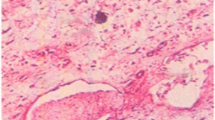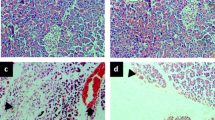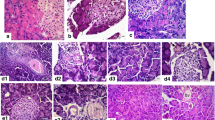Abstract
This study was designed to investigate the role of nitric oxide (NO) in the formation of pancreatic edema in caerulein-induced pancreatitis in rats. Pancreatitis was produced by two intraperitoneal injections of caerulein, and plasma amylase concentration, pancreatic edema index (pancreatic wet weight/body weight), and Evans blue extravasation (as a measure of vascular permeability) were evaluated 5h after the first injection. Four doses (1, 2.5, 5, and 10 mg/kg) of NG-nitro-L-arginine (l-NNA), an NO synthase inhibitor, were subcutaneously administered at −0.5, 0.5, 1.5, 2.5, and 3.5h after the first injection of caerulein.l-NNA significantly lowered the edema index, the wet/dry weight ratio of the pancreas, and Evans blue extravasation in the rats with pancreatitis. The maximal effect was obtained byl-NNA at a dose of 2.5 mg/kg; this inhibited the increase in pancreatic edema formation from the control value by 60%–70%. Intraperitoneal injections (20 mg/kg, five times) ofl-arginine, a substrate for NO production, partly reversed thel-NNA-induced inhibition of pancreatic edema formation, butd-arginine, an enantiomer ofl-arginine, did not show any effect. Plasma amylase concentrations were not significantly affected by any dose of L-NNA, nor were they affected byl- ord-arginine. These findings strongly suggest that endogenous NO plays an important role in the formation of pancreatic edema in caerulein-induced pancreatitis in rats, probably by increasing vascular permeability and protein extravasation.
Similar content being viewed by others
References
Lampel M, Kern HF. Acute interstitial pancreatitis in the rat induced by excessive doses of pancreatic secretagogue. Virchows Arch [A] 1977;373:97–117.
Yamaguchi H, Kimura T, Mimura K, et al. Activation of proteases in caerulein-induced pancreatitis. Pancreas 1989; 4:565–571.
Robert A, Lum JT, Lancaster C, et al. Prevention by prostaglandins of caerulein-induced pancreatitis in rats. Lab Invest 1989;60:677–691.
Konturek SJ, Dembinski A, Konturek PJ, et al. Role of platelet activating factor in pathogenesis of acute pancreatitis in rats. Gut 1992;33:1268–1274.
Griesbacher T, Lembeck F. Effects of the bradykinin antagonist, HOE 140, in experimental acute pancreatitis. Br J Pharmacol 1992;107:356–360.
Palmer RMJ, Ferrige AG, Moncada S. Nitric Oxide release accounts for the biological activity of endothelium-derived relaxing factor. Nature 1987;327:524–526.
Khan MT, Furchgott RF. Additional evidence that endothelium-derived relaxing factor is nitric oxide. In: MJ Rand, C Roper (eds) Pharmacology, Amsterdam: Elsevier, 1987;341–344.
Ignarro LJ, Buga GM, Wood KS, et al. Endothelium-derived relaxing factor produced and released from artery and vein is nitric oxide. Proc Natl Acad Sci USA 1987;84:9265–9269.
Shimosegawa T, Abe T, Satoh A, et al. NADPH-diaphorase activity in neurons of the mammalian pancreas: Coexpression with vasoative intestinal polypeptide. Gastroenterology 1993; 105:999–1008.
Satoh A, Shimosegawa T, Abe T, et al. The role of nitric oxide in the pancreatic blood flow response to caerulein. Pancreas 1994; 9:574–579.
Khalil Z, Helme RD. The quantitative contribution of nitric oxide and sensory nerves to bradykinin-induced inflammation in rat skin microvasculature. Brain Res 1992;589:102–108.
Hughes SR, Williams TJ, Brain SD. Evidence that endogenous nitric oxide modulates oedema formation induced by substance P. Eur J Pharmacol 1991;191:481–484.
Green PG, Luo J, Heller PH, et al. Neurogenic and non-neurogenic mechanisms of plasma extravasation in the rat. Neuroscience 1993;52:735–743.
Kubes P, Granger DN. Nitric oxide modulates microvascular permeability. Am J Physiol 1992;262:H611-H615.
Rawson RA. The binding of T-1824 and structually related diazo dies by plasma protein. Am J Physiol 1943;138:708–717.
Sirois MG, Plante GE, Braquet P, et al. Role of eicosanoids in PAF-induced increases of the vascular permeability in rat airways. Br J Pharmacol 1990;101:896–900.
Melero X, Guarner F, Malagelada J-R. Nitric oxide blockade inhibits pancreatic secretion in vivo but potentiates caerulein-induced acute pancreatitis. Gastroenterology 1992;103:A279.
Warzecha Z, Dembinski A, Szlachcic A, et al. Role of nitric oxide (NO) in pancreatic secretion and pancreatitis. Gastroenterology 1993;104:A342.
Lerch M, Weidenbach H, Pfaff P, et al. Vasoactive mediators involved in edema formation and vascular permeability in caerulein-pancreatitis. Pancreas 1993;8:762.
Tani S, Itoh H, Okabayashi Y, et al. New model of acute necrotizing pancreatitis induced by excessive doses of arginine in rats. Dig Dis Sci 1990;35:367–374.
D'Orleans JP, Nucci G, Vane JR. Kinins act on B1 or B2 receptors to release cojointly endothelial-derived relaxing factor and prostacyclin from bovine aortic endothelial cells. Br J Pharmacol 1989;96:920–926.
Sanfey H, Sarr MG, Bulkley GB. Oxygen-derived free radicals. Acta Physiol Scand 1986;548:109–118.
Guice KS, Miller DE, Oldham KT, et al. Superoxide dismutase and catalase: A possible role in established pancreatitis. Am J Surg 1986;151:163–169.
Wisner J, Green D, Ferrell L, et al. Evidence for a role of oxygen-derived free radicals in the pathogenesis of ceralein induced pancreatitis in rats. Gut 1988;29:1516–1523.
Niederau C, Niederau M, Borchard F, et al. Effects of antioxidants and free radical scavengers in three different models of acute pancreatitis. Pancreas 1992;7:486–496.
Schönberg MH, Büchler M, Gaspar M, et al. Oxygen free radicals in acute pancreatitis of the rat. Gut 1990;31:1138–1143.
Furukawa M, Kimura T, Yamaguchi H, et al. Role of oxygen-derived free radicals in hemorrhagic pancreatitis induced by stress and cerulein in rats. Pancreas 1994;9:67–72.
Beckman JS, Beckman TW, Chen J, et al. Apparent hydroxyl radical production by peroxynitrite: Implications for endothelial injury from nitric oxide and superoxide. Proc Natl Acad Sci USA 1990;87:1620–1624.
Hogg N, Darley-Usmar VM, Wilson MT, et al. Production of hydroxyl radicals from the simultaneous generation of superoxide and nitric oxide. Biochem J 1992;281:419–424.
Lipton SA, Choi Y-B, Pan Z-H, et al. A redox-based mechanism for the neuroprotective effects of nitric oxide and related nitrosocompounds. Nature 1993;364:626–632.
Author information
Authors and Affiliations
Rights and permissions
About this article
Cite this article
Abe, T., Shimosegawa, T., Satoh, A. et al. Nitric oxide modulates pancreatic edema formation in rat caerulein-induced pancreatitis. J Gastroenterol 30, 636–642 (1995). https://doi.org/10.1007/BF02367791
Received:
Accepted:
Issue Date:
DOI: https://doi.org/10.1007/BF02367791




